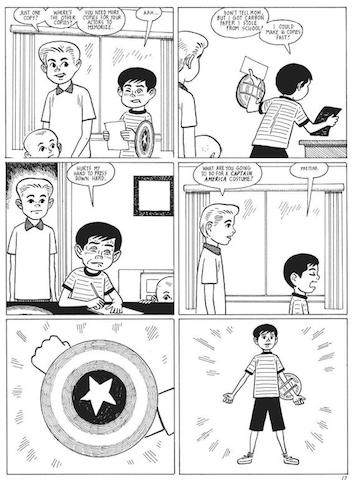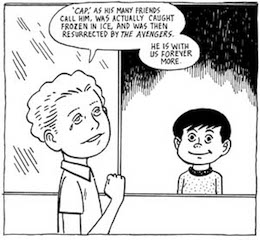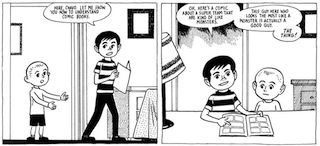![]() Marble Season by Gilbert Hernandez
Marble Season by Gilbert Hernandez
 Gilbert Hernandez is one of my favorite writers and artists, and I particularly like the way he depicts children in his comics. So I was eager to read Marble Season, a semi-autobiographical work about a boy named Huey growing up in California in the 1960s. Throughout the book, Huey simply acts like a kid, hanging out with his brothers and the other boys and girls in the neighborhood (the kids talk about the parents but they are always off-panel). That’s as much of a plot as there is, and yet, this book is pure gold because, simply put, Gilbert Hernandez is a genius.
Gilbert Hernandez is one of my favorite writers and artists, and I particularly like the way he depicts children in his comics. So I was eager to read Marble Season, a semi-autobiographical work about a boy named Huey growing up in California in the 1960s. Throughout the book, Huey simply acts like a kid, hanging out with his brothers and the other boys and girls in the neighborhood (the kids talk about the parents but they are always off-panel). That’s as much of a plot as there is, and yet, this book is pure gold because, simply put, Gilbert Hernandez is a genius.
As I mentioned in my review of Grip: The Strange World of Men, Hernandez is able to draw his characters with seeming simplicity while conveying an incredible range of emotional nuance via his minimal line work. This is true of all his characters. However, the children in his comics are particularly interesting because we expect children in comics to appear with minimal line work: After all, this minimalism is what we’ve been exposed to in popular comic strips such as Peanuts and Calvin and Hobbes. Yet, the children in comics by Hernandez seem different, more worldly than the kids in Peanuts, more so even than the often too-wise Calvin.
 This worldliness is what makes Marble Season as great as it is, and it is the product of two distinct features that set Marble Season apart from other comics like Calvin and Hobbes and Peanuts. First, the audience for Marble Season is primarily an adult one. Though I would agree that adults are also a part of the intended audience for Calvin and Hobbes, I think adults are the secondary, not primary, audience. However, in Marble Season, adults are the primary audience; children, secondary, if at all. The other distinctive feature of Marble Season is that the world the kids inhabit seems to be a dangerous, unpredictable, and frightening one at times.
This worldliness is what makes Marble Season as great as it is, and it is the product of two distinct features that set Marble Season apart from other comics like Calvin and Hobbes and Peanuts. First, the audience for Marble Season is primarily an adult one. Though I would agree that adults are also a part of the intended audience for Calvin and Hobbes, I think adults are the secondary, not primary, audience. However, in Marble Season, adults are the primary audience; children, secondary, if at all. The other distinctive feature of Marble Season is that the world the kids inhabit seems to be a dangerous, unpredictable, and frightening one at times.
This darkness, however, doesn’t turn the book into a bleak one. The kids in the comic, like kids in the real world, have a resilience that is remarkable, and their innocence protects them from much. But as adult readers, we have more awareness than the young characters. Hernandez knows that we see the world differently than the kids. He knows that we’ll realize that the crazy lady in the neighborhood is not the person the kids should be most frightened of as they run down the street, their imagination at full alert. Real physical harm is more likely to come from the bullies they fight one day and befriend the next. And it’s true that we see such fights in Marble Season: Appropriately, the boys walk away with real bruises, black eyes, and bleeding noses and mouths (though, because it is in black-and-white and drawn in a cartoonish style, the depictions of this violence are muted a little). This is a type of real violence I never saw in the newspaper funnies.
 I’m afraid that the above point isn’t enough to convince anybody to read Marble Season. Realism rarely is a prime motive for reading fiction. But the dark side of this realism is crucial because it complements the lighter side of the stories. This is the type of comic that can be read too quickly and dismissed as light because of the minimal action and dialogue. But this nothing, as in Seinfeld, is its focus. However, while Seinfeld was somewhat pathetic (though very funny) in portraying adults with nothing to do, Marble Season depicts the world of most children who grew up in the United States before 1990 (many, though not all, kids are now kept busy in activities or at least monitored by adults regularly).
I’m afraid that the above point isn’t enough to convince anybody to read Marble Season. Realism rarely is a prime motive for reading fiction. But the dark side of this realism is crucial because it complements the lighter side of the stories. This is the type of comic that can be read too quickly and dismissed as light because of the minimal action and dialogue. But this nothing, as in Seinfeld, is its focus. However, while Seinfeld was somewhat pathetic (though very funny) in portraying adults with nothing to do, Marble Season depicts the world of most children who grew up in the United States before 1990 (many, though not all, kids are now kept busy in activities or at least monitored by adults regularly).
That’s what I love about Marble Season. The kids roam, they get in trouble, they play, they cry, they work out problems on their own, and they learn to either be autonomous or ask another kid for help. Adults are not there to make sure there is zero danger, zero failure, zero tears, zero boredom, or zero unhappiness of any kind. So, if you grew up in a world where you too were allowed to roam free, then you will be able to relate to Marble Season. If you did not, if you were shuttled from activity to activity by your parents, you’ll enjoy getting a glimpse of another type of childhood. Even though there was danger (I, like most kids growing up in the 1970s, had my brushes with violence), there was something idyllic about such a childhood where, paradoxically, responsibilities were less but maturity a more probable outcome because we were forced to become self-reliant in a real world.
 I’ve hardly mentioned Huey, so I want to end by mentioning his character development. Huey lives for pretending: He wants to act out plays in the backyard with his friends, he tries his hand at a play, and he is prompted to dream bigger and starts writing a movie script. His first love, however, is comics, which he borrows from his older brother and tries to keep from his destructive younger brother. He also plays with his action figures, playing out comic book stories with them (though he hides them whenever anybody is around). By the end of the book, however, he despairs that “the only thing he knows how to do right is read comics.”
I’ve hardly mentioned Huey, so I want to end by mentioning his character development. Huey lives for pretending: He wants to act out plays in the backyard with his friends, he tries his hand at a play, and he is prompted to dream bigger and starts writing a movie script. His first love, however, is comics, which he borrows from his older brother and tries to keep from his destructive younger brother. He also plays with his action figures, playing out comic book stories with them (though he hides them whenever anybody is around). By the end of the book, however, he despairs that “the only thing he knows how to do right is read comics.”
Huey’s words are said out of sadness and anxiety about growing up to be an adult, but Hernandez is leading us to see beyond his young character’s despair, particularly since the author’s love of reading comics at a young age led him to become one of the greatest and most influential comic book writers and artists of all time. At the end of the comic, we notice three changes in Huey of which he is largely unaware. First, he has a long and serious conversation with a girl his age, showing that he is maturing socially. His conversation dips into serious life issues, too. Secondly, he starts to realize that his unthinking actions could seriously injure, even kill, another person as he reflects back on his behavior early in the book: Though he intended to be kind, Huey almost played a part in the death of a young neighborhood girl. And finally, we watch him use his creative storytelling skills to captivate an audience, but Huey is unaware at the book’s end that his hard work, though  literally child’s play, has started to show promise. In this, my favorite scene in the book, Huey casts a storytelling spell on his friend, and we get to watch her face as she gets sucked into his make-believe world. He, for once, doesn’t have to ask anybody to pretend with him—his storytelling does the trick all on its own. And he’s almost too good at it. She asks him to stop when she starts getting too frightened!
literally child’s play, has started to show promise. In this, my favorite scene in the book, Huey casts a storytelling spell on his friend, and we get to watch her face as she gets sucked into his make-believe world. He, for once, doesn’t have to ask anybody to pretend with him—his storytelling does the trick all on its own. And he’s almost too good at it. She asks him to stop when she starts getting too frightened!
I could keep writing on and on about this brilliant comic. My copy of the book has many strips of paper marking favorite scenes, but it would be best if you just bought your own copy and started marking your favorite pages. You’ll want to reread this book and share it with others. I can’t imagine anyone not liking it. And it makes a great companion to The Adventures of Venus, also by Hernandez, about a young girl about the same age as Huey. My only warning is this: Once you read Marble Season, you won’t be able to stop reading books by Gilbert Hernandez.



thanks for this really well-written review. You've definitely piqued my interest in this, particularly in how you highlight the still…
Thanks for the kind words, Ira! Much appreciated!
Fine review
What a fascinating exploration of Edwige Fenech's contributions to the giallo genre! I love how the post highlights her unique…
Pretty challenging book. Cut by half, speed up the cadence. Trying to figure out the plot, the main point of…